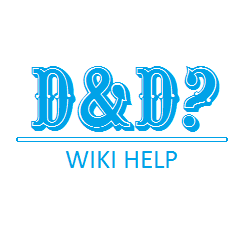Help:When to Italicize and Capitalize
Jump to navigation
Jump to search
The following are guidelines based on general observations from official WotC D&D products for 2.5e, 3e, 3.5e, 4e, and 5e.
When to Italicize
The following should always be italicized:
- Spells, powers, spell-like abilities, and psi-like abilities (greater teleport, fireball). Other special abilities or features should not be italicized, even if they mimic spells.
- Names of magic and psionic items, (ring of wizardry II, potion of bear's endurance). In 2.5e, these names are italicized when written in paragraphs, but not when appearing in tables.
- Published works (Dragon Magic, Player's Handbook, Unearthed Arcana)
- Sub-headings under bold inline headings. The lycanthrope’s special qualities section and the rogue’s special abilities section are prime examples of this.
In 2.5e in particular, words are occasionally italicized for emphasis.
When to Capitalize
The following are proper nouns. They should always be capitalized:
- Ability scores (Strength, Constitution, and Wis)
- Skills (Stealth), but not the subset of skills within the Craft, Knowledge, Perform, Profession skills [Craft (weaponsmithing), Knowledge (arcana), Perform (carnal acts), Profession (the oldest one)]
- Feats (Combat Reflexes)
- Saves (Fortitude save, Reflex save, and Will save)
- "Armor Class" and "AC"
- "Difficulty Class"
- "Hit Dice"
- One of a kind artifacts (Eye of Vecna)
- Sizes (Small)
- Names of special abilities and class features when they appear in tables1
- Special ability markers (Ex, Sp, Ps, and Su)
- Salient Divine abilities (Divine Creation)
- Planes (Material Plane)
- Domains, but not the trailing word "domain" (War domain)
- From 3e onward: languages (Dwarven and Elven). Prior to 3e, languages were common nouns.
- 3e creature types and subtypes (Aquatic, Humanoid) when used in a stat block. Some earlier statblocks in 3.5e do the same. In later 3.5e content and all editions since, these are always common nouns.
- 4e powers
- 5e class features (Fighting Style, Sneak Attack). Some features, such as spellcasting or a barbarian's rage, may be treated as common nouns when they are not in a table.
- 5e subclasses (Circle of the Land, College of Lore). Cleric domains follow separate rules (Life domain, War domain).
- 5e epic boons
The following are common nouns. They should always follow the same rules for capitalization as if you were writing a term paper for class (i.e. the beginning of a sentence, titles and headings, proper nouns, acronyms, etc...):
- Alignments (lawful good)
- Spells and powers (mage's disjunction and Mordenkainen’s disjunction)
- Special abilities (energy drain)
- Classes (rogue, monk, barbarian)
- Magic and psionic items (tome of understanding) except for one of a kind artifacts
- Mundane items (monk's outfit) and their properties (finesse and light armor)
- Races (dwarf and elves) and creatures (frost giant)
- Named bonuses (dodge, deflection, and circumstantial)
- Spell schools (necromancy) and subschools (healing)
- Power disciplines (clairsentience) and subdisciplines (scrying)
- Spell and power descriptors (force)
- Types (aberration) and subtypes (goblinoid). In 3e, these should be capitalized when used in stat blocks.
- 2.5e, 3e, and 3.5e: class special abilities. When used in class tables, these should be treated as proper nouns.1 From 4e onwards, these are almost always treated as proper nouns.
The following should never be capitalized2:
- The unit indicating die size (10d6 and d20 System Reference Document)
|
